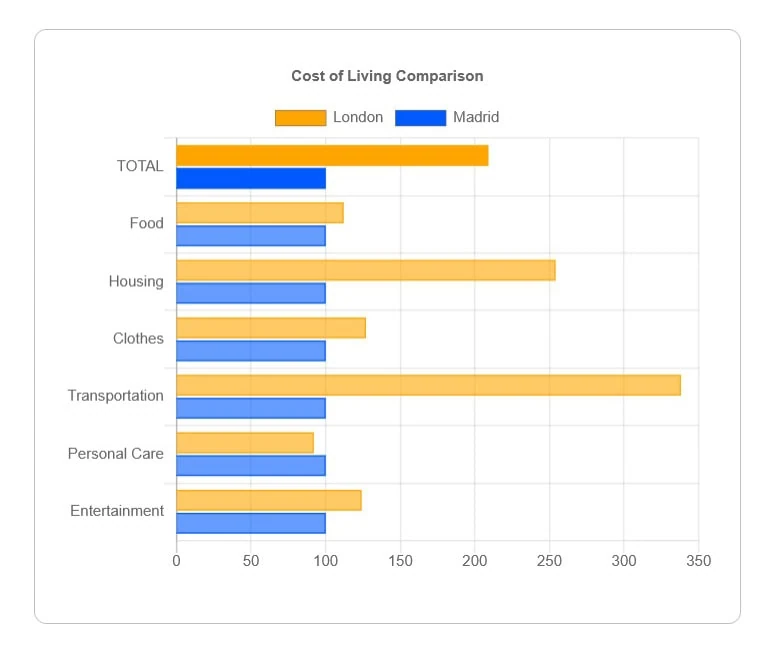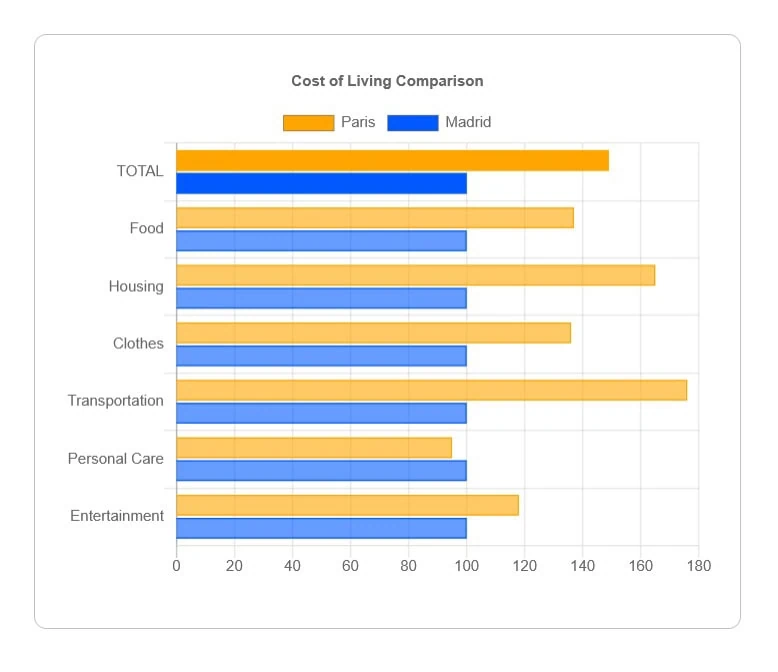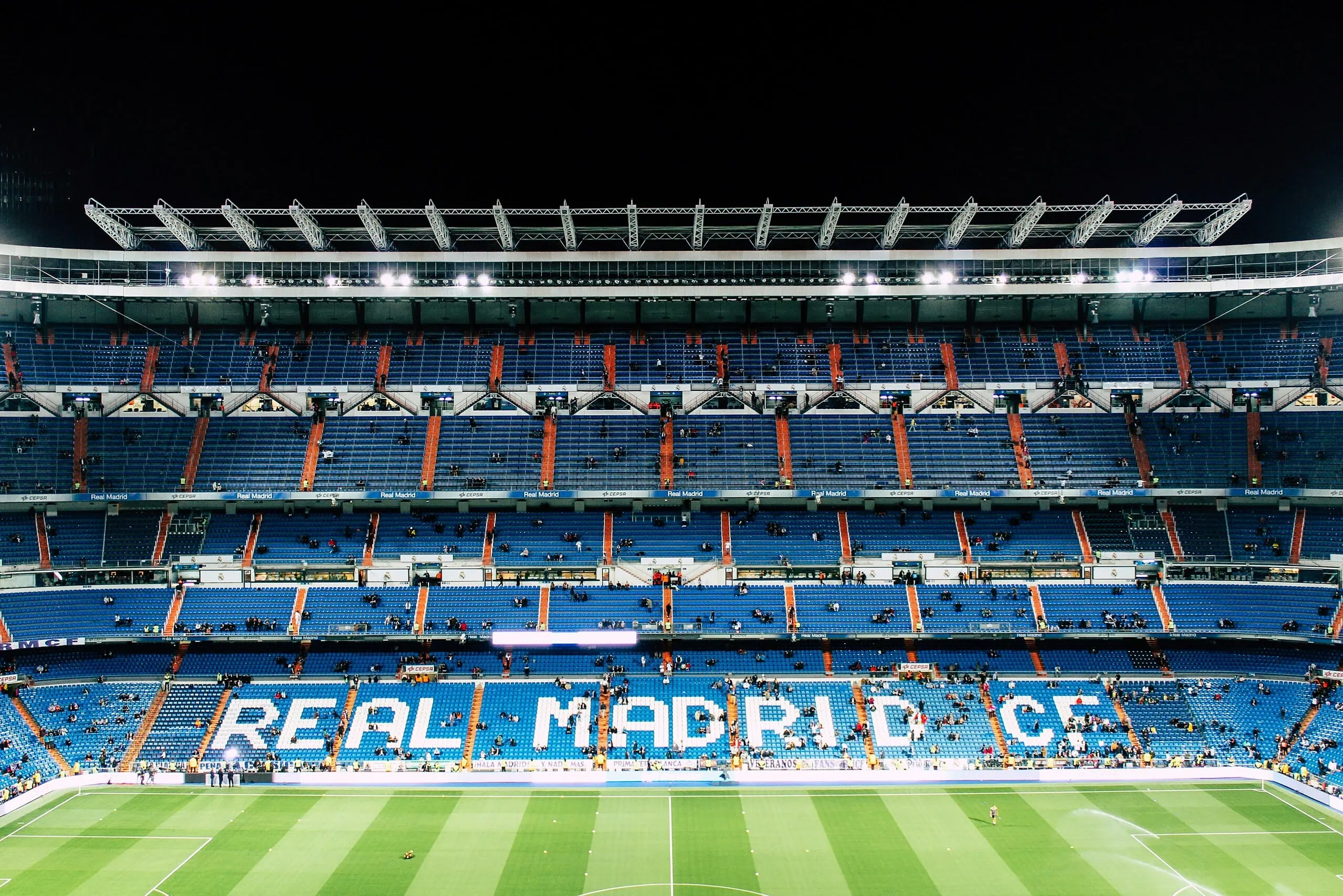NOTE: This is an older article that was updated on May 16, 2025. This is why the publish date you see was originally in 2023
Madrid offers an excellent quality of life that is very affordable. In this article we walk you through the cost of living in Madrid in 2025.
One of the biggest appeals of living in Madrid is the high quality of life enjoyed by its residents. As we detailed in our article, Why Madrid: The benefits of moving to Madrid, the city offers an excellent work/life balance, spectacular weather, a low cost of living and a very good healthcare system. In this article, we walk you through the cost of living in Madrid in 2025
.
- We start by comparing the average cost of living in Madrid to that of other cities.
- The second part of this article presents typical pricing of key cost of living components in Madrid.
The cost of living in Madrid in 2025, versus other cities
Economists compile price indices to help to compare how prices differ between time periods or geographical locations. Calculating a cost of living index is a straightforward process. According to the the website Expatistan, Madrid is one of the cheaper capital cities in Europe.

Average housing costs in major cities
As housing represents the largest monthly expense for most people, whether it be in rental prices or mortgage payments, it’s worth comparing these across major cities. Housing costs account for 30 to 42 percent of the average household budget. For city dwellers, that estimate hovers at around 40 percent of income.This illustrates why housing costs are one of the most important things to look at when considering a relocation or second home.
As you can see in the following graph, using data from the Deloitte 2024 Property Index that compares housing prices across major European cities, Parisian real estate is currently the most expensive in Europe. This is a big contrast to the situation Pre-Brexit, when London real estate was significantly more expensive than Parisian real estate.
Are you British and considering moving to Europe? If so, check out our recent article: What you need to know about post Brexit relocation to Europe
Another big change has been the price of real estate in Madrid vs. Lisbon. For many years Lisbon had cheaper real estate than Madrid. Given all the recent buzz around Lisbon that has changed and real estate in Lisbon is more expensive than real estate in Madrid. Are you trying to decide between moving to Madrid and moving to Lisbon? If so, we recommend you read our article Madrid vs. Lisbon

As you can see in the graph, real estate in northern Europe is consistently more expensive than that in the Mediterranean.
In terms of rental prices, Madrid becomes a bit more expensive. With an average price of 25.4€ per square meter, it sits well above the mean and median rental prices in other European capital cities. Moreover, rental prices have increased rapidly over the past year as Madrid as many people from South America, Mexico and the US flock to the city. Morale of the story? If you want to move to Madrid, we recommend buying a home, rather than renting it, if you have the budget.

Would you like to learn more about luxury housing in Madrid? Contact Our Founder at fabiana@madrid-estate.com or WhatsApp +34 680 306 337 to learn more about buying or renting a home in Madrid.
The cost of living in Madrid in 2025, by component
Now that we have compared average cost of living prices across countries, and looked carefully at the biggest component, let’s examine the cost of living in Madrid by individual components.

Transportation
Transportation and food both account for 15% of the average urban cost of living.
Madrid has an excellent public transportation system that is very reasonably priced. It has a subway system in the center of the city and a light rail system that services the suburbs. It also has an excellent bus network, both for short and longer haul trips. The price of a Metro ticket in the city center ranges between 1.50€ and 2€ (€1.50 for up to five stations; €0.10 for each additional station, up to a maximum of €2.00 for routes over nine stations). 10 journey tickets in the suburbs are even cheaper: 12.20€ (although there is a discount in effect until June 30 as they phase in a price increase). Compare this with Paris, where a pack of 10 journeys in 17.35€.
Food
There is a wide range of food prices in Madrid, depending upon where you shop. The German grocers Aldi and Lidl are the cheapest places to buy food and other household items. Carrefour is more expensive and the upscale Spanish chain El Corte Ingles is pricier still. If you are looking for a liter of milk, the average price is 1.04€. The average price of a loaf of bread in Madrid is 1.47€, but can be up to 6€ if you buy it in a fancy bakery. The average price of a dozen eggs is 3.24€; again that can be a lot more if you buy organic, free range eggs from a high end grocery store like El Corte Inglés.
The average prices for these goods in Paris are: a liter of milk 1.41€, a loaf of bread 1.20€ and a dozen eggs is 5.77€.
The average prices for these goods in London are: a liter of milk £1.16, a loaf of bread £1.52 and a dozen eggs is £3.97.
Healthcare
Medical care in Spain is relatively cheap: especially compared to the United States. The public healthcare system provides good service. If you have residency in Spain, you can get a health care which gives you access to the system for free, with the exception of vision, dental and pharmaceuticals. The exception to this is if you are an independent contractor and work for yourself. In this case, you must pay into the social security system to gain access to public healthcare.
You can also obtain private health insurance. This gives you access to better facilities and it is often easier to get an appointment. It costs around 70€ per month, for a healthy 40 year old, if you go with a Spanish provider. If you go with an international carrier it is often much more expensive. To learn more, we recommend you read: Everything you need to know about Spanish healthcare
Recreation
This is where you can spend a lot of money, if you want. Madrid has become more upscale in recent years and there are plenty of options to drop some cash if you are so inclined. That said, there are still many reasonably priced options for everything from eating out to sports.
Eating & drinking
Madrid used to be a very cheap place to eat out, but it lacked variety. There has been an influx of new restaurants in recent years and more international options. However, these often come with hefty price tags. If you go to an “old man bar” you can get a beer for as little as a couple euros. If you go to a more stylish option, with craft beers, you can pay north of 8€ for a pint of beer. Wine is another example. You can get a glass for as little as 4€ at a traditional restaurant, but spend well over 20€ for a glass of wine at a fancy wine bar.
The same is true of food. You can go to an old fashioned restaurant and still get a three course meal with a glass of wine (appetizer, main and coffee or dessert) for around 16€. On the other end of the spectrum is the Michelin Three Star restaurant DiverXo, where the tasting menu (which is your only menu option) is 450€.

Communication
Again, there is a wide range of options when it comes to communication providers. You can get an extremely high quality fiber optic connection (600 Mbps), including two mobile lines with unlimited data and Vodafone TV for 69€ a month from Vodafone. On the other end of the spectrum is a budget carrier, like Lowi. You can pay as little as 8€ per month for a budget mobile plan.
Conclusion
Although Madrid has become more expensive in recent years, the cost of living in Madrid in 2025 is still, on average, much cheaper than that of other European capital cities. It’s really the best of both worlds: you can live cheaply but if you want to splurge, there is an increasing number of options available. The biggest savings come in terms of necessities like housing and transportation.







